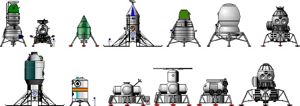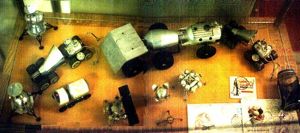
Home - Search - Browse - Alphabetic Index: 0- 1- 2- 3- 4- 5- 6- 7- 8- 9
A- B- C- D- E- F- G- H- I- J- K- L- M- N- O- P- Q- R- S- T- U- V- W- X- Y- Z
DLB Lunar Base

DLB Module Deployed
View of the DLB Soviet lunar base modules as they would appear deployed on the lunar surface.
AKA: Barminograd. Status: Cancelled 1974. Gross mass: 52,000 kg (114,000 lb).
Korolev raised the matter informally at tea with Chief Designer of rocket complexes Vladimir Pavlovich Barmin, head of GSKB SpetsMash (State Union Design Bureau of Special Machine-Building). Barmin was interested in pursuing the subject, but how could such a base be placed on the moon. 'You just design the base', Korolev assured him, 'and I'll figure out how to get it there'. The project ran 12 years and was known to SpetsMash as the 'Long-term Lunar Base' (DLB) and referred to jokingly by detractors as 'Barminograd'. It would have put a semi-permanent nine-man base on the moon by 1975.
Consideration was given to using the same elements in expeditions to other planets. Under the DLB studies SpetsMash defined purposes of the base, the principles of its construction, phases of its deployment and composition of its scientific and support equipment. The enthusiasts that worked on the project were naturally known as 'lunatics'.
The DLB would have utilized unmanned Ye-8 spacecraft designed by the Lavochkin OKB to conduct initial reconnaissance of the prospective moon base site. These would use lunar soil core drills to obtain samples of the soil and return them to earth for analysis, and Lunokhod rovers to survey the site. If the site was found to be satisfactory, these craft had radio beacons which would guide follow-on elements of the base to precision landings.
Ambitious articulated mobile nuclear-powered Lunokhod laboratories would take the cosmonauts from the landing sites on long-duration traverses of the lunar surface. The Lunokhods were equipped with core samplers and manipulators so that the crew could conduct collection of surface samples from within the pressurized cab without the need to always exit the ship and conduct surface operations in space suits. One of the main objectives of the base would be the location and mining of Helium-3 for use in nuclear fusion reactors on earth. Rare on the earth, Helium-3 was abundant on the moon, having collected in the regolith from the solar wind.
Barmin's lunar base would be crewed by nine cosmonauts and consist of nine modules. These modules would have a length of 4.5 m during launch and transport on the moon. Once position in place on the surface of the moon and inflated with air, they would telescope out to 8.6 m length with a total floor area of 22.2 square meters. Power would be provided by nuclear reactors.
The nine modules would be pre-equipped in the factory for specialized functions: command module, laboratory/warehouse module, workshop module, midpoint module, medical/gymnasium module, galley module with dining room, and three living modules. A prototype of one of these modules was used in 1967 for a one-year closed-cycle living experiment at the IBMP (Institute for Bio-Medical Problems). Based on the results of this experiment it was planned that the units on the moon would have a false window, showing scenes of the Earth countryside that would change to correspond with the season back in Moscow. The exercise bicycle was equipped with a synchronized film projector, that allowed the cosmonaut to take a 'ride' out of Moscow with return. These psychological measures were felt important to maintain the crew's mental health.
From 1969 the Ministry of Defense backed the project with more serious funding, in a view to leapfrogging the Americans by establishing a Soviet moon base after their Apollo project had been completed. In these later versions, the manned elements apparently used the improved L3 complex (designed for the follow-on two-man lunar landings) to ferry manned crews from earth orbit to lunar orbit and then from lunar orbit to the surface and back. The Block Sr LOX/LH2 stage would be used to insert the components of the DLB into low lunar orbit.
By 1971 the lunar city project was practically complete and Chief Designer Barmin arranged a meeting with Secretary Ustinov, head of all military and space rocketry. He brought along two of this 'lunatics', Aleksandr Yegorov and Vladimir Yeliseyev. The project was defended in a marathon meeting - nine presentations over six hours. At the conclusion, Ustinov agreed that the project should go ahead - but he couldn't decide, at the pace of a walk or the speed of a freight train. In the event, the point was moot. The N1 never successfully flew, and the rocket, and its associated projects, were cancelled in May 1974. In any case, the Soviet economy very likely could never have sustained the cost of the project - 80 billion dollars in 1997 prices.
The 9-man base was considered only a first stage. Elaborate models were built of larger-scale cities on the moon. Payload that needed to be delivered to the lunar surface for initial operations was 52 metric tons. Supply requirements to support operations and continued expansion of the DLB would start at 80 metric tons per year of payload delivered to the surface in 1975, increasing to 150 metric tons per year after 1980. Barmin's base modules were designed to fit within the 5.5 metric ton net surface payload of a single launch of Korolev's original N1 booster. This could later be increased to 6.5 metric tons using the 30-engine N1, then 9 metric tons using the N1M, or 15 metric tons if Chelomei's alternative UR-700 booster was developed.
Unmanned elements of the DLB designed by the Lavochkin bureau and using lunar core sampling drills designed by Barmin flew in 1969-1976 under the 'Luna' program. Although these flights were conducted in direct reconnaissance support of a manned lunar landing and lunar base, at the time it was declared that no Soviet manned lunar landing program existed, and that these unmanned flights represented a way to achieve the results of the American Apollo program without such expense and risk to life. After a number of launch vehicle failures this series of probes had some success. Luna 15 had crashed while attempting to land on the moon while the Apollo 11 astronauts were on the surface. But on September 20, 1970 Luna 16 safely soft landed on the moon and then returned lunar soil to Soviet territory. Lunokhod 1 traveled about a small portion of the Sea of Rains and returned photographs. Luna 19 mapped the gravity field of the moon in preparation of later manned flights. Luna 20 returned to earth more lunar soil, and Lunokhod 2 roved around an area representing the transition zone between the lunar maria and the highlands.
Crew Size: 9.
| DLB Module Russian manned lunar habitat. Cancelled 1974. Basic module developed by Barmin's OKB from 1962 for the Zvezda Lunar Base. Cancelled, together with the N1 booster, in 1974. |
Family: Lunar Bases, Moon. Country: Russia. Launch Vehicles: N1, N1 1969. Agency: Barmin bureau. Bibliography: 291, 292, 376, 89, 6455.
 | Lunokhod DLB Credit: © Mark Wade |
 | DLB Stow/Unstowed View of DLB Soviet lunar base modules as they would appear in short transport configuration and in inflated, telescoped deployed configuration. |
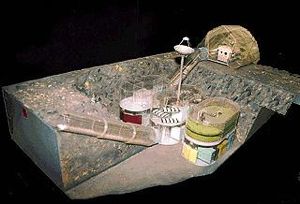 | Zvezda / DLB base Zvezda / DLB long-tern lunar base Credit: Spetsmash |
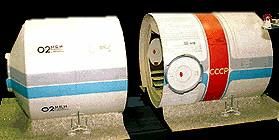 | Zvezda / DLB module Basic module for Zvezda / DLB long-tern lunar base |
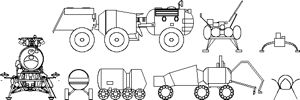 | Mars Train Elements of Mars Train and Zvezda Lunar Base Support Craft. Credit: © Mark Wade |
1962 During the Year - .
- Zvezda Long-term Lunar Base (DLB) - .
Nation: Russia.
Related Persons: Korolev.
Spacecraft Bus: DLB Lunar Base.
Spacecraft: DLB Module.
The N1 draft project of 1962 spoke of 'establishment of a lunar base and regular traffic between the earth and the moon'. Korolev raised the matter informally at tea with Chief Designer of rocket complexes Vladimir Pavlovich Barmin, head of GSKB SpetsMash (State Union Design Bureau of Special Machine-Building). 'You just design the base', Korolev assured him, 'and I'll figure out how to get it there'. Under the DLB studies SpetsMash defined purposes of the base, the principles of its construction, phases of its deployment and composition of its scientific and support equipment. The enthusiasts that worked on the project at Zvezda were naturally known as 'lunatics'.
1968 February 27 - .
- Soviet on plan through 1975 for automated probes to the moon and planets. - .
Nation: Russia.
Related Persons: Barmin,
Keldysh,
Tereshkova.
Spacecraft: DLB Lunar Base,
Luna Ye-8,
Luna Ye-8-5.
Keldysh heads a Soviet on plans through 1975 for automated probes and space research of the moon and planets. Barmin attends, his interest being the relation of this work to his lunar base. Kamanin finds the plan not well thought out... Tereshkova sees Kamanin and tells him she cannot handle the stress of both political demands on her time and cosmonaut training. She wants Kamanin's assistance to get her out of political tasks.
Back to top of page
Home - Search - Browse - Alphabetic Index: 0- 1- 2- 3- 4- 5- 6- 7- 8- 9
A- B- C- D- E- F- G- H- I- J- K- L- M- N- O- P- Q- R- S- T- U- V- W- X- Y- Z
© 1997-2019 Mark Wade - Contact
© / Conditions for Use
